| The Village Here are a few descriptions and newspaper articles we have found about the village: The following is taken from The History and Topography of The county of Essex 1836: Birdbrook. The name given to this parish is supposed to have been derived from the brook which passes over part of it. In records it is written Bridebrook, Brodebrooke, Burdbrooke, and, in Domesday, Bridebroe. The strong wet soil of this district is mixed with deep sandy loam, and, in some instances, highly productive. Average annual produce of bushels per acre - wheat 94, barley 30, oats 94. It is found exceedingly favourable to the growth of oak timber; and, among the fine standard trees to be seen in the pasture lands, one that was particularly noticed by Mr. Young, measured, at five feet from the ground, eleven feet nine inches in circumference. Poplar, maple, and plane tree, seem indigenous here, and are of luxuriant growth. A clump of alders, on the border of the Stour, in Bathorne Hall garden, has been greatly admired; they are of nearly equal dimensions, the largest of them, at the height of five feet, measuring seven feet four inches in circumference, and rising to the height of from thirty to thirty-five feet of clear timber. Birdbrook is surrounded by the villages of Ashen, Ridgwell, Stambourne, and Steeple Bumpsteeed; and the river Stour divides it from Stoke and Wiscoe, in Suffolk: its distance from London is fifty-five miles, and from Saffron Walden thirteen; from east to west it measures two miles, two furlongs, and sixteen rods; from noth to south one mile, four furlongs, and twenty-seven rods, (exclusive of the hamlet of Hersted Green), and contains about two thousand two hundred and forty-four acres of land. The following is taken from White's Directory of Essex 1848: BIRDBROOK, a pleasant village, on the bold eminence, near the chief source of the river Colne, 10 miles North West of Halstead, and 4 miles South East of Haverhill, has in its parish 557 inhabitants, and 2330 acres of land, including the small village of Baythorne End, on the high road, and on the south bank of the Stour, 2 miles North East of the church, and 3 miles from Haverhill and Clare. It has several neat mansions and scattered farm house, and the soil is generally a strong wet loam, and partly a deep sandy loam. The surface is well wooded, and picturesquely broken into hill and dale, and the views from some of the summits are extremely beautiful. The executors of the late Sir W.B. Rush are lords ot the manor, but the greater part of the soil belongs to J.P. Elwes, King Viall, A. Fitch, W. Gibbons, G.W. Gent, F. Bailey, and H. Gurney, Esqrs., and a few smaller owners. Baythorn Hall, an old mansion near the Swan, is the property of King Viall, Esq., who also owns the larger and more elegant mansion of Baythorn Park, which has extensive grounds, and stands on a bold acclivity above the river Stour, but is now unoccupied. The latter was built in 1668 by George Pyke, whose father purchased the estate in 1640, and whose descendant, of the same name, took down the gate and court walls in 1801, and new-fronted, sashed, and greatly improved the house. The park was formerly stocked with deer and has some fine large trees, especially several large oak pollards. A clump of alders in the hall gardens are much admired, each being about seven feet in girth, at the height of five feet from the ground. Several of the farm houses in this parish are fine old mansions, and that on the Moat farm is encompassed by a moat. That called Herksted Hall, now belonging to G.W. Gent Esq., was the seat of the Walfords, who purchased the Whitley estate in 1657, and greatly improved and beautified the pleasure grounds and gardens. Human bones have been dug up on Chadwell and Honex farms, and in other parts of the parish, and with them several Roman urns were found. The Church (St. Augustine,) is a small ancient structure, without aisles, but having a tower, containing three bells, and crowned by a small wooden spire. It was thoroughly repaired in 1793 and the two following years. The handsome font, and the fine painting of Jesus baptised of John in the river Jordan, were given by the late T. Walford, Esq. The rectory, valued in K.B. at £19, and in 1831 at £500, is in the patronage of Clare hall, Cambridge, and incumency of the Rev. Jph. Cape, M.A., who has a residence and 89A. 2R. 22P. of glebe. the tithes were commuted in 1843 for £600 per annum. The following is taken from The People's History of Essex by Duffield William Coller 1861 Of Birdbrook, which adjoins Steeple Bumpsted to the east, it was said last century -"In the passage from Toppesfield to this place, you are presented for upwards of half a mile with one of the finest landscapes in the county; but the pleasure received from this delightful prospect is in some measure damped upon your approach to the village, which has all the appearance of wretchedness and poverty; and indeed it is a matter of astonishment that a place so very inviting from its situation should be without one good house in it." This is libel upon the Birdbrook of the present day. It has several neat mansions and good farm-houses; and Baythorne Park, the property of Mr. King Viall, standing on the acclivity above the Stour, with its park-like pastures and its fine old trees, is sufficient in itself to redeem the parish from reproach of the surly traveller. The little church, which was thoroughly restored at the close of the last century, has a handsome font; and we are told that Martha Blewitt, who was laid within its yard in 1681, had made a complete bailue of the lords of the creation: she had had nine husbands, all in regular and lawful succession, and when she was gathered to the connubial hatch the clergyman took for the text of her funeral sermon -"Last of all the woman died also." The following article comes from East Anglian Daily Times, Wednesday, June 23, 1937 | AN ESSEX PARISH: ITS HISTORY AND ROMANCE BIRDBROOK (Four Miles S.E. of Haverhill) |
Prehaps the most prominent part of Birdbrook is the hamlet known as Baythorne End, for, in view of its situation on the comparatively busy road, running from Haverhill to Halstead, Baythorne End is well known to travellers, and more especially to those who journey by car, for on a corner stands that guide, the philosopher and friend of the motorist, the man wearing the khaki uniform of the Automobile Association. Baythorne End seems to be a village compact of aspect, and apparently complete in itself, for here are all the signs and symbols of the activity belonging to a place which depends upon its own efforts for existence, and yet can look with interested eyes on those who pass through its street without a thought of Baythorne End's existence. There are several old houses here which seem to typify the quiet homes of the English rural districts; there are others, less attractive, and more modern in apperance; and there are one or two shops which cater for the prople who make their homes in this particular place, a place which, through the rush and bustle of traffic, suggests the atmosphere of a small town, reared amidst the quietude of the rural districts. 
| 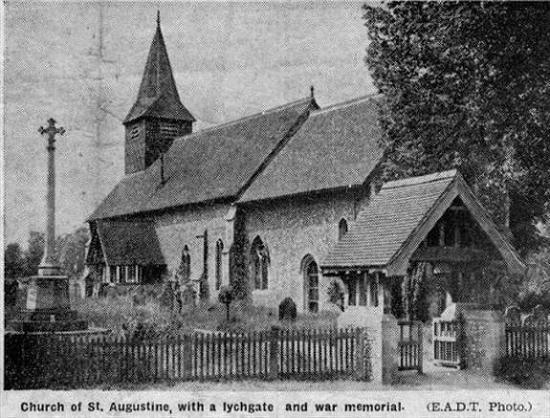
| | 
It is close by here that Baythorne Park can be discovered, and with its wide expanse of green turf, it emphasises the peace and the cool serenity of the friendly countryside. Yet it is more than probable that few of those who travel through Baythorne, and in the doing appreciate something of the fresh and sober beauties of the pleasant landscape as revealed by Baythorne Park, are aware that actually Baythorne is but half a village, if so described, and that the other half is in a situation sufficiently remote from the rush and roar of traffic to make it a place which has changed but little in the course of many years. | Several monuments can be seen in the nave, including a rather imposing affair on the North wall, which refers to Thomas Walford, who left this world in 1833, and who besides filling a position of some consequence in Essex as its Deputy-Lieutenant, attained fame in the sphere of learned research, being a Fellow of the Antiquarian, Linnean and Geological Societies of London. An early memorial, also quite impressive, bears the name of George Pyke, of Baythorne House, who died in 1738, whilst his nephew and heir, John Pyke, and Anne, wife of the latter, are also commemorated. Below this is the tablet of John Pyke's niece, who predeceased her uncle, and this adds interest to another memorial referring to James Walford, for James Walford's wife was no other than the above mentioned niece. | 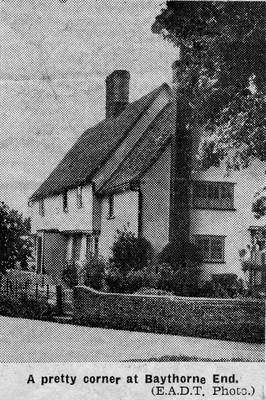 | 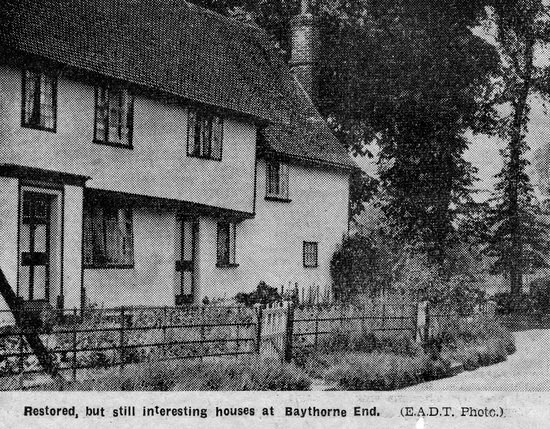 | To discover Birdbrook of which, as we have seen, Baythorne End is a kind of hamlet - even although the offspring seems rather more active than the parent! - one takes a road leading past a station, a station appearing so tiny from a distance that in it there is a suggestion of a child's plaything rather than an essential of modern transport and development. And, presently, after an up hill journey, so that the country is spread below in all sorts of picturesque patterns, one reaches Birdbrook village itself. | From these impressive memorials to those who bent the knee in prayer beneath the roof of this pleasant little church, we come to two others far less dignified in character, but whose very quaintness makes them - in some quarters, at least - of outstanding interest, although the interest is rather reminiscent of the fair-booth than a place of worship! And, to emphasise the strangeness, both inscriptionsrefer to frequent excursions into the realms of matrimony. One tells of a certain Robert Hogan, whose death occurred about the middle of the eighteenth century. This very much married man had led a bride to the alter on no fewer than seven times, the final occasion being on the first day of the first month in the year 1739. | As I have mentioned, the atmosphere of the past is very obvious in Birdbrook even although one or two habitations of slate and brick contrast with the older and more artistically designed dwellings. There is a tiny green here fronting the house of worship, so that in the appearance of the latter, set as it is in a churchyard which seems to have been lifted bodily from the surrounding countryside, is the very essence of peace and the consequent detachment from the cares of the world outside. There is an inn bearing the homely sign of the Plough, an inn whose weather-worn thatch and irregularity of design must prove an inspiration to the artist, for in this same thatch and irregularity there is something almost beautiful and certainly appealing. There is other thatch in the street, including a whole line of cottages crowned with this attractive style of roofing, whilst, as a fitting accompaniment, from the tall trees which dignify the outskirts of the village comes the incessant cawing of rooks. | 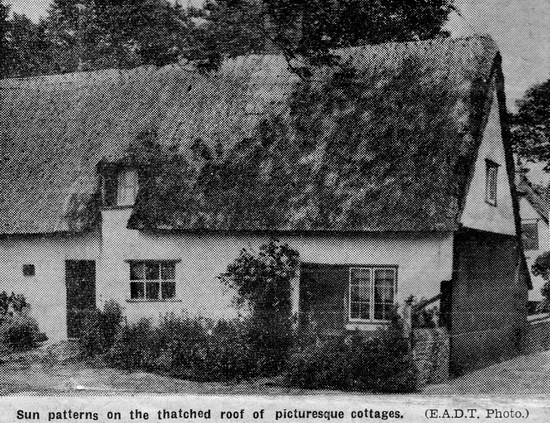 | 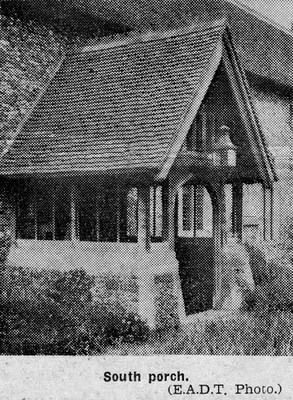 | Trust the gentler sex to score in this, as in other directions, however! The other inscription in Birdbrook Church reveals the astounding fact that Martha Blewitt, who for some time presided over the destinies of the Swan Inn - incidentally, this hoselry is still very much in evidence at Baythorne End - was sufficiently attractive to become the spouse of nine men in succession, although as her inscription states, somewhat regretfully, "last of all ye woman dy'd allsoe," and was buried on the seventh of May, 1681, leaving her ninth and last husband to mourn his loss - although, in view of the good lady's matrimonial history one can imagine him feeling somewhat gratified that he had not shared the fate of his eight predecessors, and thus given Mistress Blewitt another opportunity of exercising her charms. Truly an extraordinary coincidence that in Birdbrook Church should be the record of two such remarkable happenings. But, leaving this subject, which is introduced merely as a matter of curiosity, and coming to other things, we find that piscina exists in the South wall of the nave, close to the tower, a position so uncommon as to deserve notice. The tower possesses a good arch, but in this connection we find examples of that strange mentality which is too often revealed in ancient buildings, and for whose existence psychologists might supply reason. For on the tower arch various initials have been scratched, embroidered by dates of the eighteenth and nineteenth centuries, and although of course, for most of these small boys were responsible. There is no doubt that such pursuits have a fascination for those old enough to know better, but who by such desecration seek an easy way to perpetuate their names. | As one usually discovers, the house of worship harmonises delightfully with its nearby surroundings, more especially through the fact that its tower is surmounted by one of those shingled spires so frequently to be found in Essex, and whose wood, coloured by the changing weather, seems to merge gracefully into the landscape, moreover, entrance to the churchyard, in which is the cross reared to the men of the village, who made the supreme sacrifice in the war, is dignified by the existence of a lychgate, and here again is something entirely in keeping with the general environment. Dedicated to St. Augustine, the church possesses besides the tower mentioned, chancel, nave and South porch only, but the latter is certainly interesting through the existence of a stoup originally used for Holy water. Unfortunately, however, like so many of its kind, this has suffered considerbly, not so much through age as by the hand of some misguided iconoclast in years long gone who found in this ancient survival something on which to vent his spleen. | 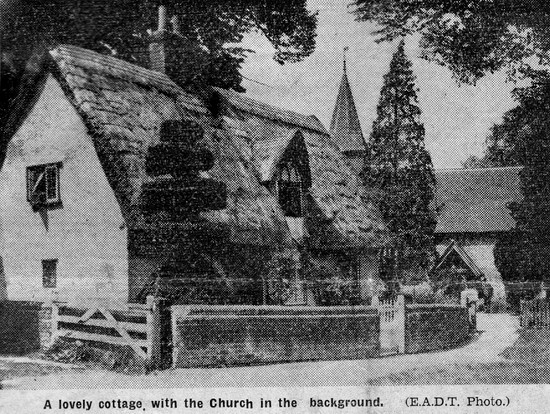 | Several monuments have been raised in this friendly little house of worship, cheifly of the eighteenth and nineteenth centuries. However, one very ancient affair remains, for in the floor to the South of the sanctuary, is a stone revealing matrices from which the brasses which formerly graced it have been removed, whilst close by is a stone coffin lid, and this, quite possibly, may have been connected with the founder of the church. On the North wall of the chancel have been erected mural monuments to former incumbents, one of whom, Jonathan Walton, D.D. rector and rural dean, who died in 1846, had officiated here for some forty-three years. Another tablet refers to his successor, Joseph Cape, M.A., whose death occured in 1866, and above this is commemorated James Hills Manley, R.N., who died in 1876, and whose son, another incumbent, erected the memorial. | Little more remains to be said about the church, but so far as birdbrook itself is concerned it seems to have possessed close associations with those early invaders of our country, the victorious legions of Rome. For within the boundaries of Birdbrook earthworks have been revealed which are believed to have been reared by the Romans, whilst other discoveries provide further links with the same people, who on the heels of war and bloodshed brought peace and prosperity to the land they won at the sword's point. And so we will leave this most peaceable of villages, set so serenely on the Essex upland overlooking th e spot where rises the river from which Colchester gets its name. Little of excitment has occured here, but in its very tranquillity there is the charm ever belonging to places which owe their very existence to the soul from which the majority of their people have wrested a living for centuries past, and with whose problems they will struggle for many a year to come. e spot where rises the river from which Colchester gets its name. Little of excitment has occured here, but in its very tranquillity there is the charm ever belonging to places which owe their very existence to the soul from which the majority of their people have wrested a living for centuries past, and with whose problems they will struggle for many a year to come. YEOMAN |
|
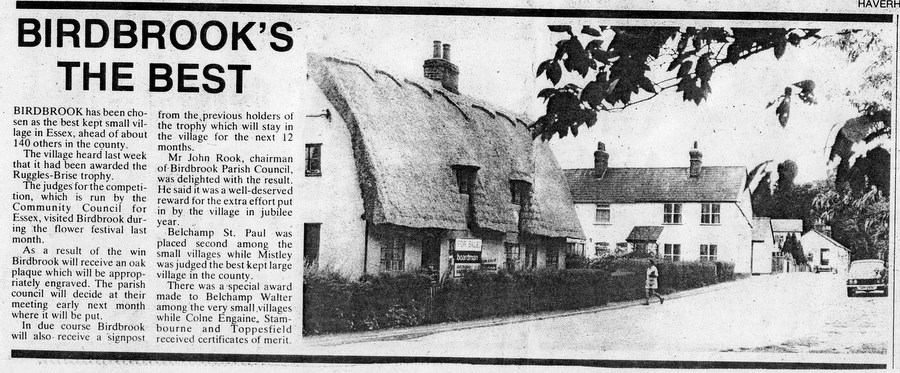
The above cutting comes from The Haverhill Echo, July 14, 1987. Back History Next Home |







